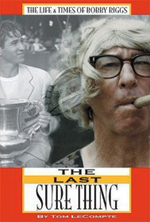The Forgotten Career of
Frank Kovacs
Tom LeCompte
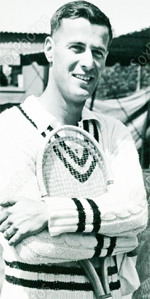
When we think of bad actors in tennis, the names usually come from the age of TV media--Ilie Nastasie, Jimmy Connors, John McEnroe, or currently, Nick Kyrgios. Perhaps we think back to Bobby Riggs who played the role of media clown during the run up to his loss to Billie Jean King in the so called battle of the sexes.
But Frank Kovacs? The vast majority of tennis fans have never heard his name, much less the bizarre, disruptive and occasionally hilarious details of his antics during the era when Bobby Riggs was at the top of the game. Kovacs may be forgotten but in his era he was dubbed the original clown prince of tennis.
Much like Art Larsen, whose charismatic personality and obsessive compulsive behavior are detailed by Gardnar Mulloy in his series Will To Win (Click Here), Frank Kovaks is a player lost in tennis history, supremely talented, but never a winner of a major title. Instead he was a supporting actor in an era in which the quirks of the players were not subject to the 24 hours news cycle or even at times the discipline of the governing bodies in tennis.
Few pictures of Kovacs survive and it is nostalgic to think of him as a forgotten man in a bye gone and magical era. But Kovac's career was closely intertwined with many other top players, some of whom openly despised him.
No relationship was more intimate or consequential that his relationship with Bobby Riggs, as we will see. But before turning to Riggs, let's see the background and then describe Kovac's insane encounter with the great Gene Mako at Forest Hills in 1938.
The Story
What was the Frank Kovacs story? Tall and handsome, Kovacs had literally grown up in the shadow of Don Budge. The two lived on the same street in Oakland, a couple of blocks away from each other.
Four years younger than Budge, Kovacs was the son of an upholstery worker, Frank Sr., who had emigrated from Hungary in 1910. The tall youth started playing paddle tennis at 12, switching to tennis after several months and getting a few pointers from Budge's older brother, Lloyd, also an accomplished player.
After five months of pleading, he convinced his father to buy him his first racquet. It was "a thing of rare beauty, at $3.98," recalled Kovacs. Little did he know at the time that he would have rackets named for him, including an innovative, open throat model he played with at the height of his career.
At 14, Kovacs scraped up enough money to buy some lessons, and he began to emulate his neighbor, Don Budge. In many ways his game reminded people of Budge's in its sustained power, with a big serve, picture perfect groundstrokes, and a punishing return of service. And like Budge, his best shot was his backhand, a shot he liked to hit hard and low over the net at a sharp angle crosscourt.
When he played well, Kovacs seemed unbeatable, capable of putting on dazzling displays of talent. He was considered for the Davis Cup team in 1938, but was dropped after his coach and mentor, George Hudson, got into a dispute with the USLTA when it banned him from acting as Kovacs' manager.
As brilliant as .Kovacs was, he was also wildly unpredictable. A true screwball, he often seemed more interested in hamming it up for the galleries than playing serious tennis. He would joke around, resort to trick shots, and tease his opponent.
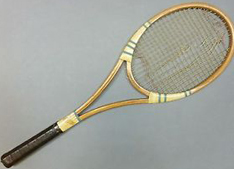
In the San Francisco City Championships one year, he threw up three balls on his service, striking the middle one for a clean ace. Another time, in the semifinal of a tournament in Glen Cove, N.Y, Kovacs raced down a ball that pulled him far wide of the court, sent up a high lob, and while everyone else watched the ball, he proceeded to sit down in the grandstand and applaud his opponent's smash into an empty court, leaving a bewildered opponent, chair umpire, and many in the audience to wonder where he had disappeared to.
His antics made him popular with fans. Young girls swooned over him, begging for autographs. He strung along girlfriends in cities wherever he went, mooching money, meals, and places to stay before unceremoniously dumping them.
But many players considered Kovacs' behavior a deliberate attempt to disrupt play and antagonize them. At the same time, Kovacs could also be his own worst enemy. Just as often his behavior would sabotage his own game, as it did in the third round of the national championships at Forest Hills in 1938 against Gene Mako, the American great and doubles partner of Budge, who held Kovacs in open contempt.
Mako Tunes Kovacs
As Mako described the events of the match, "First of all, he's 35 or 40 minutes late at , Forest Hills, the national championship. The offtcials come over to me and they say, Now look, if you want to you can have him defaulted: But I don't want a default, so I say let's wait a while .
"Well, how long do you want to wait?
"I don't care. Let's wait.
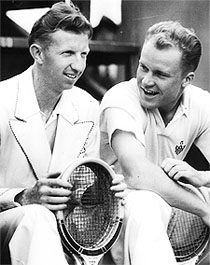
'About fifteen to twenty minutes later, he comes in with 17 racquets under his arm, sauntering. And he says "Call it since we spin the racquet to decide who serves and I said whatever I said and he drops all 17 racquets.
"You see, he thinks that's supposed to be funny.
"In the meantime, by the way, I had asked Budge to warm up with me. We always would warm each other up for ten, fifteen, twenty, thirty minutes before we'd play. Well, I was warm and ready to go, real ready.
"So when I see this chickenshit guy doing this stuff, I say to myself all I have to do is hang in with this guy and I will win. I have no way to lose if I hang in. That's the first thing you have think of when you play with a guy who's chickenshit.
"It was on Court 6 or something, one of the back courts where there aren't bleachers, but people can stand around and watch. And there are maybe 200 people standing around, and they're all tittering and laughing a little bit.
"He has on sort of a half-assed topcoat or something. It was an overcast day, but it wasn't cold. So we walk out on the court to warm up, and the first ball I hit to him, he runs around it and hits a backhand on the forehand side. The second ball he hits between his legs, which gets everybody laughing. And then the third one he hits behind his back.
"Then he says, 'Are you ready?'--like it's a joke. "Yes, I am. The guy in the chair goes, Linesmen ready? Players ready? Play.
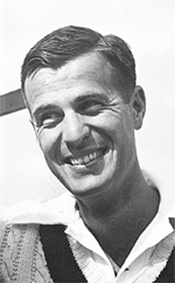
"He starts serving, and I won the first game and we change sides and he takes a big sweater off. Then I hold serve and break him the second time he serves. He takes another sweater off. He's still got a couple more under there, which I didn't know. Now it's 3-love. Now, I hold serve and break him again. It's 5-love.
"He takes another sweater off. In the meantime, everybody is laughing. And while they're laughing it's 6-love, 2-love in the second set. I won the first eight games while he was jacking off before he won a game.
"He's giving me a set plus two games, literally. I won that set 6-2, and then the third set he played like a son-of-a-bitch and I beat him 8-6. So in the most important tournament of the year he loses 6-0, 6-2, 8-6 in the third round because he's an asshole."
Mako went on to the final, where he lost to his best friend and doubles partner, Budge, capping Budge's history-making Grand Slam. Said Budge in 1941 of growing up with Kovacs, "When Kovacs forgot his horseplay, I very often could get only two or three games a set from him ... There's nobody he can't beat."
To this Kovacs answered, "Budge is all wrong. Me get serious? Honestly, when I get grim on the court I dump the ball into the net or drive it over the fence. I can't stand the strain of being tense. It makes me want to scream, and sometimes I do. I've got to have laughs to play good tennis."
Who's assessment was correct? In 1941, Kovacs' professional debut seemed to confirm Budge's view. Before over 11,000 fans at Madison Square Garden in New York., Kovacs defeated Budge in 3 sets. Was Kovacs one of the most promising players in history to never realize his potential?
Next: Kovacs contentious rivalry with Bobby Riggs.




